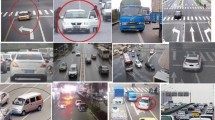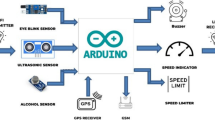Abstract
The intelligent transportation system can make traffic decisions through the sensory data collected by vehicles to ensure driving safety, improve traffic efficiency and traffic environment. Thus, the system has been widely concerned by industry and academia. However, the intelligent transportation system confronts several challenges in location privacy protection and data security during data aggregation. To solve these challenges, we propose a security-enhanced privacy-preserving data aggregation scheme for the intelligent transportation system, named SEPDA. Specifically, the SEPDA scheme utilizes the Chinese Remainder Theorem, Modified Paillier Cryptosystem and T-N Threshold Sharing to protect the location privacy and information security of vehicles, and obtains the mean and variance in the data report reading and analytics process. The SEPDA also uses the threshold cryptosystem to enhance the security of the traffic management center, which can avoid single-point attacks. Meanwhile, SEPDA employs batch authentication technology to reduce authentication overhead. Detailed security analysis and performance evaluation show that the SEPDA can resist various security threats and has low computational complexity, communication overhead and communication delay.






Similar content being viewed by others
Data availability
All of the material is owned by the authors and/or no permissions are required.
References
Ayyasamy RK, Shaikh FB, Lah NSBC, Kalhoro S, Chinnasamy P, Krisnan S (2023) Industry 4.0 digital technologies and information systems: implications for manufacturing firms innovation performance. In: 2023 International Conference on Computer Communication and Informatics (ICCCI), pp 1–6. https://doi.org/10.1109/ICCCI56745.2023.10128638
Djenouri Y, Belhadi A, Djenouri D, Srivastava G, Lin JC-W (2023) A secure intelligent system for internet of vehicles: case study on traffic forecasting. IEEE Trans Intell Transp Syst. https://doi.org/10.1109/TITS.2023.3243542
Wang H, Xu Y, Wang Z, Cai Y, Chen L, Li Y (2023) CenterNet-Auto: a multi-object visual detection algorithm for autonomous driving scenes based on improved CenterNet. IEEE Trans Emerg Top Comput Intell. https://doi.org/10.1109/TETCI.2023.3235381
Chen Z, Cao H, Zhao S, Li M, Yi B, Guo W, Song X (2022) An LMIs-based back-stepping sliding mode control framework for robust velocity tracking of the automatic driving vehicle on sloped roads. Int J Robust Nonlinear Control 32(10):6148–6183
Kumar VR, Eising C, Witt C, Yogamani S (2023) Surround-view fisheye camera perception for automated driving: overview, survey & challenges. IEEE Trans Intell Transp Syst 24(4):3638–3659
Kiac M, Sikora P, Malina L, Martinasek Z, Srivastava G (2023) ADEROS: artificial intelligence-based detection system of critical events for road security. IEEE Syst J. https://doi.org/10.1109/JSYST.2023.3276644
Hou S, Yin H, Pla B, Gao J, Chen H (2023) Real-time energy management strategy of a fuel cell electric vehicle with global optimal learning. IEEE Trans Transp Electrif. https://doi.org/10.1109/TTE.2023.3238101
Cao M, Li VO, Shuai Q (2022) Book your green wave: exploiting navigation information for intelligent traffic signal control. IEEE Trans Veh Technol 71(8):8225–8236
Hu P, Chu X, Lv L, Zuo K, Ni T, Wang T, Shen Z (2023) An efficient and secure data collection scheme for predictive maintenance of vehicles. Ad Hoc Netw 146:103157
Cui Y, Cao Z, Xie Y, Jiang X, Tao F, Chen YV, Li L, Liu D (2022) Dg-labeler and DGL-MOTS dataset: boost the autonomous driving perception. In: IEEE/CVF Winter Conference on Applications of Computer Vision, WACV 2022, Waikoloa, HI, USA, January 3–8, 2022. IEEE, pp 3411–3420. https://doi.org/10.1109/WACV51458.2022.00347
Liu Y, Guo W, Fan CI, Chang L, Cheng C (2018) A practical privacy-preserving data aggregation (3PDA) scheme for smart grid. IEEE Trans Ind Inform 15(3):1767–1774
Zheng Z, Li Z, Li J, Jiang H, Li T, Guo B (2022) Utility-aware and privacy-preserving trajectory synthesis model that resists social relationship privacy attacks. ACM Trans Intell Syst Technol (TIST) 13(3):1–28
Lu R, Liang X, Li X, Lin X, Shen XS (2012) EPPA: an efficient and privacy-preserving aggregation scheme for secure smart grid communications. IEEE Trans Parallel Distrib Syst 23(9):1621–1631
Liu Z, Cao Z, Dong X, Zhao X, Liu T, Bao H, Shen J (2021) EPMDA-FED: efficient and privacy-preserving multidimensional data aggregation scheme with fast error detection in smart grid. IEEE Internet Things J 9(9):6922–6933
Le C, Lu R, Cao Z (2015) PDAFT: a privacy-preserving data aggregation scheme with fault tolerance for smart grid communications. Peer-to-Peer Netw Appl 8(6):1122–1132
Yuan J, Wang Y, Ji Z (2022) An efficient privacy preserving scheme for distributed data aggregation in smart grid. Int J Control Autom Syst 20(6):2008–2020
Gai N, Xue K, Zhu B, Yang J, Liu J, He D (2022) An efficient data aggregation scheme with local differential privacy in smart grid. Digit Commun Netw 8(3):333–342. https://doi.org/10.1016/j.dcan.2022.01.004
Kong Q, Lu R, Ma M, Bao H (2017) A privacy-preserving sensory data sharing scheme in Internet of Vehicles. Future Gener Comput Syst 92:644–655
Hu P, Wang Y, Gong B, Wang Y, Li B (2020) A secure and lightweight privacy-preserving data aggregation scheme for Internet of Vehicles. Peer-to-Peer Netw Appl 13(1):1–12
Yan X, Ng WW, Zeng B, Lin C, Liu Y, Lu L, Gao Y (2021) Verifiable, reliable, and privacy-preserving data aggregation in fog-assisted mobile crowdsensing. IEEE Internet Things J 8(18):14127–14140
Xiang X, Cao J (2022) An efficient authenticated key agreement scheme supporting privacy-preservation for smart grid communication. Electric Power Syst Res 203:107630
Ma X, Li B, Kong Q, Ouyang Y, Lu R (2021) On secure and efficient data sharing for smart grids: an anti-collusion scheme. In: ICC 2021—IEEE International Conference on Communications
Zhang W, Liu S, Xia Z (2022) A distributed privacy-preserving data aggregation scheme for smart grid with fine-grained access control. J Inf Secur Appl 66:103118
Wang X, Liu Y, Choo K-KR (2021) Fault-tolerant multisubset aggregation scheme for smart grid. IEEE Trans Ind Inform 17(6):4065–4072. https://doi.org/10.1109/TII.2020.3014401
Peng C, Luo M, Wang H, Khan MK, He D (2022) An efficient privacy-preserving aggregation scheme for multidimensional data in IoT. IEEE Internet Things J 9(1):589–600. https://doi.org/10.1109/JIOT.2021.3083136
Lu R, Heung K, Lashkari AH, Ghorbani AA (2017) A lightweight privacy-preserving data aggregation scheme for fog computing-enhanced IoT. IEEE Access 5:3302–3312
Kong Q, Yin F, Lu R, Li B, Wang X, Cui S, Zhang P (2021) Privacy-preserving aggregation for federated learning-based navigation in vehicular fog. IEEE Trans Ind Inform 17(12):8453–8463. https://doi.org/10.1109/TII.2021.3075683
Kong Q, Lu R, Yin F, Cui S (2021) Privacy-preserving continuous data collection for predictive maintenance in vehicular fog-cloud. IEEE Trans Intell Transp Syst 22(8):5060–5070. https://doi.org/10.1109/TITS.2020.3011931
Ren Y, Qiu S, Liu T, Liu Z, Cai W (2022) Non-contact ultralow rotational speed measurement of real objects based on rotational doppler velocimetry. IEEE Trans Instrum Meas 71:1–8
Hussain R, Lee J, Zeadally S (2020) Trust in VANET: a survey of current solutions and future research opportunities. IEEE Trans Intell Transp Syst 22(5):2553–2571
Jia X, Wang D, Nie D, Luo X, Sun JZ (2019) A new threshold changeable secret sharing scheme based on the Chinese remainder theorem. Inf Sci 473:13–30
Song Y, Xu C, Zhang Y, Li F (2020) Comments on an identity-based signature scheme for VANETs. J Syst Archit 112(6):101851
Cheng W, Guilley S, Carlet C, Mesnager S, Danger J-L (2020) Optimizing inner product masking scheme by a coding theory approach. IEEE Trans Inf Forensics Secur 16:220–235
Li B (2021) Verifiable secret sharing scheme based on certain projective transformation. Am J Comput Math 11(2):175–188
Huang P-C, Chang C-C, Li Y-H (2022) Efficient (\(k\), \(n\))-threshold secret sharing method with cheater prevention for QR code application. J Internet Technol 23(1):155–163
Ma R, Chen H-H, Huang Y-R, Meng W (2013) Smart grid communication: its challenges and opportunities. IEEE Trans Smart Grid 4(1):36–46
Acknowledgements
This work was partially supported by National Natural Science Foundation of China (Grant No. 61972438), Natural Science Foundation of Anhui Province (Grant No. 2208085QF200), Natural Science Research Project for Universities in Anhui Province (Grant Nos. KJ2021A0090, 2022AH050197 and 2022AH052367), and Wuhu Science and Technology Bureau Project (Grant No. 2023jc17).
Author information
Authors and Affiliations
Corresponding author
Ethics declarations
Conflict of interest
The authors declare that they have no known competing financial interests or personal relationships that could have appeared to influence the work reported in this paper.
Additional information
Publisher's Note
Springer Nature remains neutral with regard to jurisdictional claims in published maps and institutional affiliations.
Rights and permissions
Springer Nature or its licensor (e.g. a society or other partner) holds exclusive rights to this article under a publishing agreement with the author(s) or other rightsholder(s); author self-archiving of the accepted manuscript version of this article is solely governed by the terms of such publishing agreement and applicable law.
About this article
Cite this article
Zuo, K., Chu, X., Hu, P. et al. Security enhanced privacy-preserving data aggregation scheme for intelligent transportation system. J Supercomput (2024). https://doi.org/10.1007/s11227-024-05995-0
Accepted:
Published:
DOI: https://doi.org/10.1007/s11227-024-05995-0




